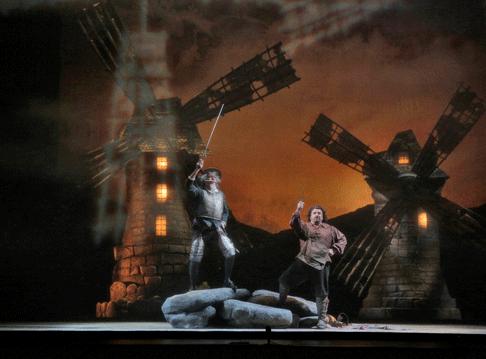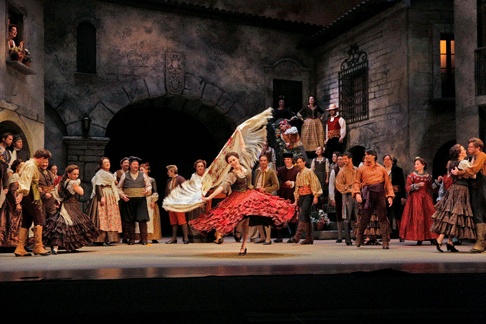Is it not equally mad to let a great opera company like San Diego Opera die when it could live on with different leadership?
On Saturday night, April 5, 2014, San Diego Opera (SDO) presented what may be its last production, a revival of Jules Massenet’s Don Quichotte. On March 20, General Director Ian Campbell announced that the company would “shut down with dignity” on April 14. SDO is not out of money, but it can no longer afford the deluxe productions it has staged in the past. The move was a total surprise to the employees, but only one of the board members voted against the closing. At the Saturday evening performance of the Massenet opera, Campbell was booed unmercifully when he attempted to speak to the audience. Since his announcement of the closure, almost twenty-one thousand SDO fans have signed a petition to keep opera in San Diego. It can be found here. The Save the Opera Campaign can be found online here.
 Don Quixote and Sancho Panza fight the giant windmills.
Don Quixote and Sancho Panza fight the giant windmills.
Don Quichotte (Don Quixote) is an opera in five acts that Jules Massenet composed to a French libretto by Henri Caïn. Although Massenet's comédie-héroïque relates to the great Spanish novel by Miguel de Cervantes, it is closer to Jacques Le Lorrain’s play Le Chevalier de la Longue Figure, which was first seen in Paris in 1904. The opera, written in 1909 for the Russian bass Feodor Chaliapin, was first performed early the following year at the Opéra de Monte Carlo. The composer may have also thought of himself as a Don Quixote, because at the age of sixty-seven, he was in love with his twenty-seven year old Dulcinea, Lucy Arbell.
Don Quichotte is a vehicle for a charismatic singer with a low voice. Italian bass Ferruccio Furlanetto is one of the truly great artists of our time and an opportunity to enjoy his interpretation of the character created by Cervantes is most welcome, even if the circumstances surrounding it are painful. In 2009, the opera was first staged in San Diego for Furlanetto. Both then and in 2014, his fully engaged character portrayal, his personal magnetism, and above all his glorious singing made the audience fall in love with the madly idealistic knight. San Diego has a large Spanish-speaking population and they were particularly in evidence for this French take on an author with whose work they are most familiar.
Keturah Stickann’s traditional production followed both Caïn’s libretto and Massenet’s music with great care, but added twenty-first century lighting and stagecraft. She told her story in a most creative manner and showed applicable quotations from the original Cervantes work in translation before each scene. The Windmill Scene was particularly memorable because the music seems to be turning the huge blades as they emerged from the fog. Conductor Karen Keltner, a specialist in French music, was at her best as she gave us a musically apt description of the mind of the ingenious gentleman from La Mancha. Missy West’s exquisite costumes and Kristina Cobarrubia’s colorful Flamenco dances added visual excitement to the production. The sets by Ralph Funicello combined with Marie Barrett’s lighting to show the bare bones landscape of rural Spain.
 Flamenco Dancing in Don Quichotte
Flamenco Dancing in Don Quichotte
Eduardo Chama’s Sancho Panza was an amusing peasant who really cared for his master. Vocally, he seems to have lost some resonance since 2009, but his able portrayal of the character made up for it. Anke Vondung was a flirtatious but innately practical Dulcinea who sang with a chocolate cream voice. Hervé Blanquart was a frightening head bandit while Chad Frisque, Michael Blinco, Anthony Ballard, and Joseph Grienenberger were mean-looking thugs. Others in the cast who added much to the production as a whole were Joel Sorenson as Rodriguez, Simeon Esper as Juan, Michaëla Oeste as Pedro, and Susannah Biller as Garcias. Choral music is often important in French opera and this work is no different. Charles F. Prestinari’s group sang with precision as they floated their delicious harmonies out into the auditorium. It’s sad to think that they and their instrumental colleagues may have much less work after the end of this season.
Maria Nockin
Cast and production information:
Rodriguez, Joel Sorenson; Juan, Simeon Esper; Pedro, Michaëla Oeste; Garcias, Susannah Biller; Dulcinea, Anke Vondung; Don Quixote, Ferruccio Furlanetto; Sancho Panza, Eduardo Chama; Ténébrun Chief Bandit, Hervé Blanquart; Conductor, Karen Keltner; Director Keturah Stickann; Choreographer, Kristine Cobarrubia; Scenic design, Ralph Funicello; Costume design, Missy West; Lighting design, Marie Barrett; Chorus Master, Charles F. Prestinari; Supertitles, Ian Campbell.


